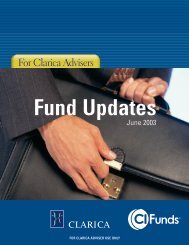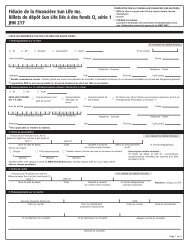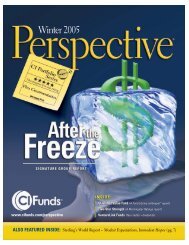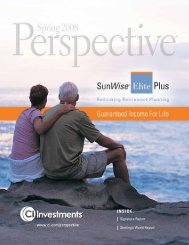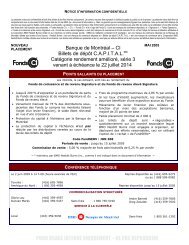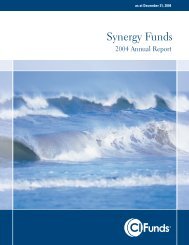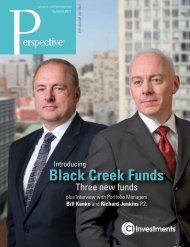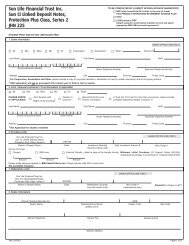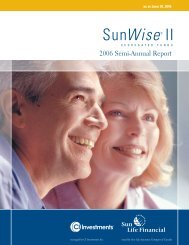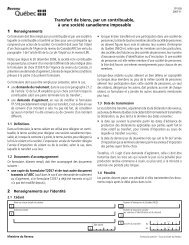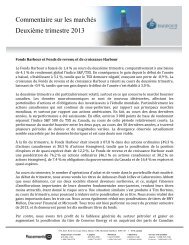Sterling’sWorld ReportThat said, we would not be particularly concerned in thenear term about fiscal deficits “crowding out” private creditformation until private credit growth actually takes off in aself-sustaining fashion. And to the extent a resumption ofeconomic growth brings with it higher tax revenues and asharp decline in fiscal deficits, the crowding out process maynot be as painful as many investors currently fear. As we havediscussed in these reports before, the early stages of recoveryfrom a credit crisis are apt to occur as a “credit-less recovery.”What is required is not that banks start lending and businessesand consumers start borrowing aggressively again, but merelythat both sides of the credit market stop trying to reduce theircredit exposure as aggressively as before.A “credit-less recovery” could be surprisingly robustwe have been particularly impressed with the resilience ofU.S. retail sales and auto output in recent months. The datasuggest that U.S. GDP growth this year will get a significantboost from final consumer demand, as well as being supportedby inventory rebuilding.Naturally, to complete the story of a self-sustaining recoverywe will need to see meaningful job growth. That wouldpermit a “virtuous circle” of higher labour income leadingto stronger consumer spending, which in turn would leadto further job creation, and so on. We remain optimisticthat such a dynamic will be evident in coming months,particularly since one of the most pronounced features of theU.S. recession was the severity of the decline in jobs acrossmany sectors.Chart 3 illustrates this process with data from the FederalReserve’s Senior Loan Officer Survey, which has been areasonably good leading indicator of U.S. real GDP growth.According to the January survey results, which were releasedin February, bankers are no longer tightening credit standardson balance even though they have also not begun to ease theirstandards significantly. However, that is a huge improvementfrom a year ago, when bankers were tripping over themselvesto tighten standards. As shown in the chart, the improvementin the Fed survey speaks to a meaningful improvement inU.S. GDP growth over the next four quarters – but with noimplication that U.S. bankers are about to go on a lendingbinge.In our view, the improvement in financial conditions seenin this indicator, or in closely related indicators like theBloomberg Financial Conditions Index, continue to pointtoward surprisingly strong U.S. growth in coming quarters,with quarterly growth rates more likely in the range of 4% to5% rather than the 2.5% to 3.0% range currently expected byconsensus surveys. And even though severe winter weathermay have obscured some of that dynamic in the first quarter,Wall Street economist Ed Hyman has noted that U.S. payrollemployment fell by a remarkable 6.1% during the recessioneven though the historical relationship between real GDPand employment would have justified a cut in employmentThe Fed’s Loan Survey is a Good Leading IndicatorIt Speaks to Substantial GDP Gains in Coming QuartersPercent (%), 1-Quarter Lag,Inverted ScaleYOY % Change-40.0 10.0%-20.00.020.040.060.080.0 Semior Loan SurveyReal GDP YOY100.099 00 01 02 03 04 05 06 07 08 09 10Source: Haver AnalyticsChart 3: Aggressive quantitative easing by the Federal Reserve hasresulted in a major improvement in lending conditions in the U.S.,which should support firm GDP growth in coming quarters.8.0%6.0%4.0%2.0%0.0%-2.0%-4.0%PAGE 16 • SPRING 2010 PERSPECTIVE AS AT MARCH 31, 2010
Sterling’sWorld Reportof only 3.7%. That suggests strongly that firms may have overreactedduring the recession and need to normalize theirstaffing now that business conditions and corporate profitshave improved markedly. Since we did not see U.S.-stylejob cuts in other developed economies like those of Europeor Japan, it would not be surprising to see a more vigorousrecovery in job growth and labour income in the U.S. thanin other developed nations.U.S. payroll employment data for April were supportive of thenotion that a self-sustaining recovery is now assured. Not onlydid <strong>March</strong> payroll employment rise by 162,000, but Januaryand February revisions added 62,000 more to the count.On top of that, we have seen the manufacturing purchasingmanagers’ survey rise to a six-year high at the same time thatunemployment claims have declined to an 18-month low.Economic activity firming in Europe and JapanIf the improvement in the U.S. economic picture wereoccurring in a vacuum, that would be a matter for concern.Fortunately, the global economic recovery appears to beincreasingly broad-based. In Europe, for example, compositepurchasing managers’ survey readings for both the U.K. andthe Eurozone have risen to nearly 57 on a 100-point scale,which is consistent with real GDP growth rates in the rangeof 2.5% to 3.5% for the first half of 2010. Moreover, theimprovement in activity appears to be broadly evident acrossmost European economies with the exception of Greece,where the recession is deepening. Otherwise, most Europeancountries are experiencing higher exports, increased domesticcapital spending and a reduced inventory drawdown. All ofthose forces are helping to offset a stagnant trend in consumerspending throughout much of Europe.Arguably, the outlook for consumer spending in Europeshould continue to improve along with evidence thatunemployment rates are set to peak. Some encouraging datain that regard come from Germany, where employment andvacancies have been rising for several months in a nation thatsuffered one of the deepest downturns in Europe.Japan has also been reporting surprisingly good economic data,with the growth rate of real GDP averaging nearly 3% overthe past year. Although Japan’s recovery was initially rathernarrowly based on net exports and public works spending,recent surveys point toward improved capital spending anddomestic consumption and strong improvements in businesssentiment among both small and large firms.Despite reasonably upbeat data from Japan, there appearsto be a growing dissatisfaction among key political leadersin Japan regarding the Bank of Japan’s de facto acceptanceof deflation. Consumer price inflation in Japan has beencontinuously negative since September 1998, only fivemonths after the Bank of Japan achieved legal independence.The only exception to the general deflation trend was the June-December 2008 period, as shown in Chart 4. In late <strong>March</strong>,the ruling Democratic Party of Japan (DPJ) announced theformation of an “Anti-Deflation Alliance” composed of 91members of the DPJ who advocate setting ambitious targetsfor real GDP growth and nominal GDP growth in 2011 of 4%and 6%, respectively, which implies 2% inflation as measuredby the GDP deflator.The purpose of the DPJ’s Anti-Deflation Alliance is topressure the Bank of Japan to adopt more aggressivequantitative easing measures. It is too early to determine howmuch traction this group will achieve in meeting its goals, butit potentially represents the most revolutionary shift in Japan’seconomic policy dialogue in decades. It may also reflectrecognition by Japanese policy analysts that Japan’s extremedebt-to-GDP ratio of above 200% as shown in Chart 2 is nolonger sustainable and can only be dealt with in the context ofhigher nominal GDP growth and a higher trend in inflation.PAGE 17 • SPRING 2010 PERSPECTIVE AS AT MARCH 31, 2010
- Page 5: Signature Reportof the average bond
- Page 8 and 9: Signature ReportSignature Diversifi
- Page 10: Signature ReportMarket RoundupGloba
- Page 13 and 14: Signature ReportHealth careTechnolo
- Page 15 and 16: Signature ReportHigh-yield bondsGeo
- Page 17: Sterling’sWorld ReportIs Greece a
- Page 22 and 23: Spotlight onStephen JenkinsGood man
- Page 24 and 25: Spotlight onStephen JenkinsHarbourF
- Page 26 and 27: Spotlight onStephen JenkinsAryzta A
- Page 28 and 29: Harbour Growth & Income FundHarbour
- Page 30 and 31: Balanced OpportunitiesFundHarbour G
- Page 32 and 33: CI IncomeOpportunities -Fund Highli
- Page 34 and 35: Reprinted with permission from The
- Page 36 and 37: COMMENTARYCambridge AdvisorsMost of
- Page 38 and 39: COMMENTARYFor the income portfolios
- Page 40 and 41: COMMENTARYquarters, the backdrop fo
- Page 42 and 43: COMMENTARYinventories throughout th
- Page 44 and 45: COMMENTARYEpoch Investment Partners
- Page 46 and 47: COMMENTARYTetrem Capital Management
- Page 48 and 49: COMMENTARYLegg Mason Capital Manage
- Page 50 and 51: COMMENTARYAltrinsic Global Advisors
- Page 52 and 53: pressure, investors will be searchi
- Page 54 and 55: Fund Factsas at March 31, 2010Fund
- Page 56 and 57: Fund Factsas at March 31, 2010Fund
- Page 58 and 59: Fund Factsas at March 31, 2010Fund
- Page 60 and 61: Fund Factsas at March 31, 2010Fund
- Page 62 and 63: Fund Factsas at March 31, 2010Fund
- Page 64 and 65: Fund Factsas at March 31, 2010Fund
- Page 66 and 67: Fund Factsas at March 31, 2010Fund
- Page 68 and 69:
Fund Factsas at March 31, 2010Fund
- Page 70 and 71:
Fund Factsas at March 31, 2010Fund
- Page 72 and 73:
Fund Factsas at March 31, 2010Fund
- Page 74 and 75:
Fund Factsas at March 31, 2010Fund
- Page 76 and 77:
Fund Factsas at March 31, 2010Fund
- Page 78 and 79:
Fund Factsas at March 31, 2010Fund
- Page 80 and 81:
Fund Factsas at March 31, 2010Fund
- Page 82 and 83:
Fund Factsas at March 31, 2010Fund
- Page 84 and 85:
Fund Factsas at March 31, 2010Fund
- Page 86 and 87:
CI Funds ® LEAD MANAGERCDN $FUND C
- Page 88 and 89:
CI Corporate ClassLEAD MANAGERCDN $
- Page 90 and 91:
Labour-sponsored FundsLEAD MANAGERC
- Page 92 and 93:
CI Segregated FundsIssued by Unity
- Page 94 and 95:
Clarica PortfolioSegregated FundsIs
- Page 96 and 97:
SunWise ® I FundsBasic GuaranteeIs
- Page 98 and 99:
SunWise ® II FundsBasic Guarantee
- Page 100 and 101:
SunWise ® II FundsCombined Guarant
- Page 102 and 103:
SunWise ® II FundsCombined Guarant
- Page 104 and 105:
SunWise ® II FundsFull Guarantee c
- Page 106 and 107:
SunWise ® Elite FundsBasic Guarant
- Page 108 and 109:
SunWise ® Elite FundsCombined Guar
- Page 110 and 111:
CI Sales TeamNeal KerrSenior Vice-P
- Page 112:
2009Analysts’ ChoiceInvestment Fu



